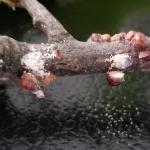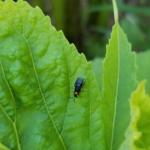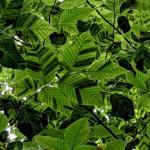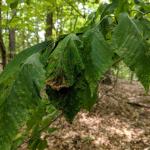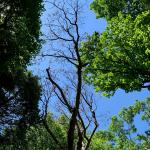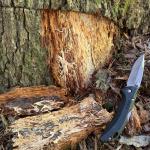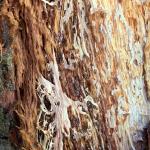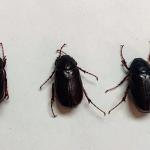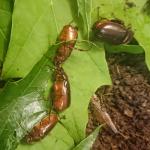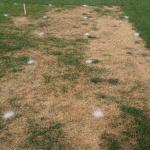UMass Extension's Landscape Message is an educational newsletter intended to inform and guide Massachusetts Green Industry professionals in the management of our collective landscape. Detailed reports from scouts and Extension specialists on growing conditions, pest activity, and cultural practices for the management of woody ornamentals, trees, and turf are regular features. The following issue has been updated to provide timely management information and the latest regional news and environmental data.
UMass Extension has developed a listing of resources for commercial horticulture operations in Massachusetts to help keep you informed and aware of relevant policies and best practices for landscapers, turf managers, arborists, nurseries, garden centers, and greenhouse producers.
For our COVID-19 Information and Support for Landscapers, Nurseries, Turf Managers, Garden Centers, Arborists, and Greenhouse Operations in Massachusetts, go to https://ag.umass.edu/landscape/news/covid-19-information-support-for-landscapers-nurseries-turf-managers-garden-centers.
The Landscape Message will be updated weekly in June. The next message will be posted on June 26. To receive immediate notification when the next Landscape Message update is posted, be sure to join our e-mail list.
To read individual sections of the message, click on the section headings below to expand the content:
Scouting Information by Region
Environmental Data
The following data was collected on or about June 17, 2020. Total accumulated growing degree days (GDD) represent the heating units above a 50° F baseline temperature collected via our instruments for the 2020 calendar year. This information is intended for use as a guide for monitoring the developmental stages of pests in your location and planning management strategies accordingly.
|
MA Region/Location |
GDD |
Soil Temp |
Precipitation
|
Time/Date of Readings |
||
|
1-Week Gain |
2020 Total |
Sun |
Shade |
|||
|
CAPE |
88 |
423 |
64 |
59 |
0.07 |
12:00 PM 6/17 |
|
SOUTHEAST |
100.5 |
492.5 |
87 |
63 |
2.25 |
3:00 PM 6/17 |
|
NORTH SHORE |
93.5 |
501 |
60 |
59 |
0.37 |
4:00 PM 6/17 |
|
EAST |
99 |
550.5 |
76 |
66 |
0.72 |
6:00 PM 6/17 |
|
METRO |
96.5 |
523 |
61 |
57 |
0.12 |
5:30 AM 6/17 |
|
CENTRAL |
98 |
512.5 |
58 |
53 |
0.18 |
7:15 AM 6/17 |
|
PIONEER VALLEY |
101.5 |
538 |
69 |
59 |
0.41 |
4:00 PM 6/17 |
|
BERKSHIRES |
80.5 |
471.5 |
64 |
59 |
0.73 |
8:15 AM 6/17 |
|
AVERAGE |
95 |
502 |
67 |
59 |
0.61 |
_ |
|
n/a = information not available |
||||||
Updated on 6/16, this map of MA shows "Abnormally Dry" (D0) conditions exist in 9 of our 14 counties: https://droughtmonitor.unl.edu/CurrentMap/StateDroughtMonitor.aspx?MA
To track water use restrictions by town, regularly check the MassDEP map: https://www.mass.gov/doc/water-use-restrictions-map/download
Phenology
| Indicator Plants - Stages of Flowering (BEGIN, BEGIN/FULL, FULL, FULL/END, END) | ||||||||
|---|---|---|---|---|---|---|---|---|
|
PLANT |
CAPE |
SE |
NS |
EAST |
METRO |
CENT |
PV |
BERK |
|
Catalpa speciosa (northern Catalpa) |
* |
Begin |
* |
Begin |
Begin |
Begin |
Begin |
Begin |
|
Sambucus canadensis (American elderberry) |
* |
Begin |
Begin/Full |
* |
* |
Begin |
Full |
Begin/Full |
|
Ligustrum spp. (privet) |
* |
Full |
Begin/Full |
Begin/Full |
Begin |
Begin |
Begin/Full |
Begin |
|
Kalmia latifolia (mountain laurel) |
Begin/Full |
Full |
Full |
Begin/Full |
Full |
Full |
Full |
* |
|
Cornus kousa (Kousa dogwood) |
Begin/Full |
Full |
Full |
Full |
Full |
Full |
Full |
Full |
|
Cotinus coggygria (common smokebush) |
Begin |
Full |
Full |
Full |
Full/End |
Full/End |
Full |
Begin |
|
Weigela florida (old fashioned Weigela) |
Full/End |
Full |
Full/End |
Full/End |
Full |
End |
Full/End |
Full |
|
Chionanthus virginicus (fringe tree) |
Full |
End |
Full |
Full/End |
Full/End |
Full/End |
End |
Full/End |
|
Deutzia spp. (Deutzia species) |
Full/End |
Full/End |
Full/End |
Full/End |
Full/End |
Full/End |
Full/End |
Full/End |
| * = no activity to report/information not available | ||||||||
Regional Notes
Cape Cod Region (Barnstable)
General Conditions: The average temperature for the period from June 10 – June 17 was 63˚F with a high of 77˚F on June 12 and a low of 47˚F on June 17. The period began with mostly cloudy days and some dense fog but has ended with mostly sunny days. Less than one tenth of one inch of rain fell in the past week. Topsoil moisture is short to very short, subsoil moisture is short to adequate. Moisture stress – which occurs when the water in a plant's cells is reduced to less than normal levels, think wilting - is being seen in lawns and some woody plants like dogwoods are showing some leaf curl as a result of low soil moisture.
Pests/Problems: The reddish-brown bodies of adult female Lecanium scales are easily seen on twigs of infested trees at this time. If you peel the females off the twigs it will reveal masses of tiny white eggs that are protected under the female’s body (see photo below). Defoliated trees, primarily oak, can be seen here and there in the Upper Cape region. The defoliation is the result primarily of cankerworm but some winter moth damage is also visible. Neither caterpillar is present at this time. Many areas of white pine are seeing drastic needle loss likely as a result of white pine needle disease (WPND). Other insects or insect damage seen during the period includes black turpentine beetle damage to pitch pine and white pine, dogwood sawfly damage to alternate leaf dogwood, rose slug sawfly windowpaning damage on rose (larvae not present), Viburnum leaf beetle damage on Viburnum (larvae not present), adult Hibiscus sawfly ovipositing on hardy Hibiscus (see photo below), aphids on Viburnum, hemlock elongate scale on hemlock and eriophyid mites on cherry, linden and hickory. Other disease signs or symptoms observed during the period include sycamore anthracnose on sycamore, maple anthracnose on Japanese maple, brown rot on ‘Kwanzan’ cherry, what looks like bacterial canker on ‘snow fountain’ weeping cherry, hemlock-blueberry or hemlock-Hydrangea rust on hemlock, black spot on rose, severe apple scab on crabapple, leaf spot on sourwood (Oxydendrum arboreum) and red thread in turf. Weeds in bloom include multiflora rosa (Rosa multiflora), white clover (Trifolium repens), creeping buttercup (Ranunculus repens), hawkweed (Hieracium spp.), yellow wood sorrel (Oxalis stricta) and curly dock (Rumex crispus). Rabbits are abundant. Keep yourself protected from ticks with permethrin treated clothing and footwear.
Southeast Region (Dighton)
General Conditions: The week started with 2.25 inches of much needed rain in a single blessed event. The timing was perfect for Bristol County Aggie had just seeded their corn fields. The germination seemed almost instantaneous and 100 percent. Turtles are on the move. I've stopped to assist in crossing the street a large, one-eyed, snapper and a red-eared slider in the past week. Fireflies are delightfully abundant in the evenings. Bees, butterflies, syrphid flies and many others are pollinating flowers. Dragon flies await in ambush. Robin fledglings are out of the nest and hiding in the hedges, some with tragic results. Catbirds are already greedily eyeballing green blueberries. Among the plants I've noticed flowering are: Pyracantha spp. (firethorn), Hydrangea arborescens (climbing Hydrangea), H. paniculata (lacecap Hydrangea), Spirea spp., Kalmia latifolia (mountain laurel), Dianthus (pinks), Digitalis lutea (perennial foxglove), D. purpurea (biennial foxglove), Syringa reticulated (tree lilac), Rosa spp., R. virginiana (Virginia rose), R. rugosa (beach rose), R. 'Knockout', R. 'New Dawn', Ilex glabra (inkberry), Lonicera sempervirens (trumpet honeysuckle), Cornus kousa (Chinese dogwood), Leucanthemum x superbum (shasta daisy), Papaver somniferum (opium or breadseed poppy), P. nudicaule (Iceland poppy), Sambucus canadensis (black elderberry), Viburnum dentatum (arrowwood), Allium spp. (ornamental onion), Achillea millefolium (yarrow), Astilbe spp. (goatsbeard), Baptisia australis (blue false indigo), Hemerocallis spp. (early daylilies), Stachys byzantina (lamb's ears), Viola tricolor (johnny jump up), Paeonia spp. (peony), Catalpa speciosa (Catalpa), Nepeta spp. (catmint), Physocarpus opulifolius (ninebark), Trifolium repens (white clover), T. pratense (pink clover), Sedum spp. (prostrate yellow Sedum), Lilium spp.(Asiatic lilies), Penstemon spp. (beardtongue), Campanula spp.(bellflower), Aquilegia spp. (columbine) and Weigela.
Pests/Problems: Noted as problems were Clematis wilt and groundhogs eating up Echinacea. Often thought of as weeds, the following were seen in bloom: Verbascum thapsus (yellow mullein), Plantago lanceolata (buckhorn plantain), Lamium spp.(deadnettle), Solanum dulcamara (bittersweet nightshade), Hieracium pratense (yellow hawkweed), Medicago lupulina (black medic), Persicaria bicornis (pink smartweed), Cichorium intybus (chicory) and Silene latifolia (white campion). One of the worst non-native, invasives, currently perfuming the air with its sprays of nickel-sized white blossoms, is Rosa multiflora (multiflora rose/Asian rambler rose). You can see how it takes over abandoned meadows completely, out competing native plants upon which native wildlife depend. See more about it in this fact sheet from Penn State: https://www.nrcs.usda.gov/Internet/FSE_DOCUMENTS/nrcs142p2_018028.pdf
North Shore (Beverly)
General Conditions: Dry conditions continue to persist. Very little precipitation was received during this period. Approximately 0.37 inches of rain fell at l\Long Hill at the beginning of this reporting week on Thursday June 12. The rest of the days were sunny and dry. Lawns are starting to show browning due to drought stress. Temperatures were mild and seasonable for this time of the year. The average daily temperature for this period was 64℉ with the maximum temperature of 83℉ recorded on June 12 and the minimum temperature of 46℉ recorded on June 17. Several plant species were observed in bloom at Long Hill; woody plants in bloom include mountain laurel (Kalmia latifolia), some Rhododendrons (Rhododendron spp.), Chinese dogwood (Cornus kousa), beautybush (Kolkwitzia amabilis/Linnaea amabilis), Weigela (Weigela florida), silver bells (Styrax japonicus), Chinese Calycanthus (Calycanthus chinensis), tulip tree (Liriodendron tulipifera), fringe tree (Chionanthus virginicus) and Carolina allspice (Calycanthus floridus). Herbaceous plants observed in bloom include garden peony (Paeonia lactiflora), Allium (Allium spp.), Rodgersia (Rodgersia spp.), lady’s mantle (Alchemilla mollis), goat’s beard (Aruncus dioicus), catmint (Nepeta cataria), cranesbill (Geranium spp.) and water lilies (Nymphaea spp.)
Pests/Problems: Due to the lack of rain in the last several weeks, some plants are starting to show signs of drought stress. Make sure to water recently planted trees, shrubs and perennial plants. Deer browsing was noted on Hostas and some shrubs. Skeletonized leaf damage by Viburnum leaf beetle larvae continued to be seen on American cranberry Viburnum and arrowwood Viburnum. Leaf and flower galls (Exobasidium vaccinii) continue to be observed in considerable numbers on some azaleas. Prune out the galls and discard in the trash (not compost) before they turn white and start to release spores. Multiflora rose (Rosa multiflora) and wild raspberry (Rubus rosifolius) weeds are in full bloom and are easy to identify. Ticks and mosquitoes are very active. Make sure you protect yourself with appropriate repellents before you go into areas with vegetation, especially out in the woods.
East Region (Boston)
General Conditions: We have been enjoying warm sunny days. We did receive 0.72” of beneficial rain on the 11th. There is a lot of activity throughout the landscape. A variety of butterflies have been observed around perennial borders. Honey bees have been out in abundance especially enjoying the full bloom of the often-planted catmint (Nepeta spp.). Lady bird beetles and their larvae are feasting on a wide variety of aphids. The occasional common privet (Ligustrum vulgare) that escaped the hedge shears is flowering. Linden Viburnum (Viburnum dilatatum) is in full bloom. Over the last week, low temperatures have ranged from 47°F to 66°F, averaging 56°F and high temperatures have ranged from 67°F to 85°F, averaging 73°F. We have gained 99 GDDs to bring the total to 550.5 GDDS for the year. The fruit of mulberries is ripe.
Pests/Problems: Lack of precipitation is a concern; unirrigated soils are dry. Cottony Camelia/Taxus scale (Pulvinaria floccifera) is prevalent on holly, Rhododendron and Taxus. Witchhazel blight caused by the fungus Phyllosticta hamamelidis is making brown lesions on witchhazel leaves. https://ag.umass.edu/landscape/fact-sheets/phyllosticta-leaf-blotch The curling, stunted leaves on Cornus florida (dogwood) is likely a sign of the dogwood anthracnose fungi Discula destructiva. Crabapples continue to suffer from a myriad of fungal pathogens affecting the foliage.
Metro West (Acton)
General Conditions: We welcome the first day of summer on Saturday with this week’s report and with a gain of 96.5 GDD during this recording period and with miniscule total of 0.12” of rain. For the most part this past week, we’ve experienced pleasant days with moderate temperatures in the mid-70s and cool nights. The historical monthly average rainfall for June is 3.93” and a meager 0.63” of rain has been recorded for this month so far. Much is in bloom at this time and observed in some stage of bloom this past week were the following woody plants: Buddleia spp. (butterfly-bush), Calycanthus floridus (Carolina allspice), Catalpa speciosa (northern Catalpa), Chionanthus retusus (Chinese fringetree), C. virginicus (American fringetree), Cornus kousa (Kousa dogwood), Cornus sericea (redosier dogwood), Cotinus coggygria (smoketree), Kalmia latifolia (mountain laurel), Ligustrum spp. (privet), Philadelphus coronarius (sweet mock orange), Physocarpus opulifolius (common ninebark), P. opulifolius 'Summer Wine' (summer wine ninebark), Potentilla fruiticosa (Potentilla), Rhododendron spp. (Rhododendron and azalea), Rosa gallica (French rose), R. glauca (shrub rose), R. 'Knockout' (knockout family of roses), Rosa rugosa (beach rose), Rosa spp. (rose), Rubus spp. (bramble, blackberry), Spiraea japonica 'Alpina' (Daphne Spirea), S. spp. (bridal wreath), Syringa reticulata (Japanese tree lilac), Tilia cordata (littleleaf linden) and Weigela florida (old fashioned Weigela). Woody vines observed in bloom were: Clematis spp. (Clematis), Hydrangea anomala petiolaris (climbing Hydrangea), Lonicera sempervirens (trumpet honeysuckle) and Wisteria spp.
Contributing even more color and interest to the landscape are some flowering herbaceous plants including: Achillea millefolium (yarrow), Alchemilla mollis (lady's mantle), Allium spp. (ornamental flowering onion) including Allium giganteum (giant onion) and A. schoenoprasum (chives), Amsonia hubrichtii (Arkansas blue star), Aquilegia canadensis (columbine), Aquilegia spp. (columbine), Aruncus aethusifolius (dwarf goat’s beard), A. dioicus (goat’s beard), Baptisia australis (false blue indigo), Campanula takesimana ‘Elizabeth’ (bell flower), C. spp. (bell flower), Centaurea montana (cornflower/batchelor’s button), Chrysogonum virginianum (green and gold), Clematis recta 'Purpurea' (Clematis), Delphinium spp. (larkspur), Dianthus deltoides (maiden pink), Dicentra eximia (fringed bleeding heart), Dictamnus albus (gas plant), Digitalis purpurea (foxglove), Filipendula spp. (meadow sweet), Geranium sanguineum (cranesbill Geranium), Hemerocallis 'Stella D'Oro' (daylily), Hemerocallis spp. (daylily), Iris sibirica (Siberian Iris), I. versicolor (blue flag iris), Lilium spp. (lily), Silene coronaria /Lychnis coronaria (rose campion), Lupinus 'Russell Woodfield Hybrids' (lupine), Maianthemum racemosum (false Solomon seal), Nepeta spp. (ornamental catmint), Paeonia spp. (peony), Papaver orientale (poppy), Penstemon digitalis 'Husker Red' (beardtongue), Phlox divaricata (Canadian Phlox), P. stolonifera (creeping phlox), Potentilla tridentata (cinquefoil), Primula spp. (primrose), Salvia nemerosa (Salvia), Saponaria ocymoides (rock soapwort), Sedum kamtschaticum (Russian stonecrop), Thymus praecox (thyme)and Tradescantia spp. (spiderwort).
Pests/Problems: According to the US Drought Monitor map released on June 18th, as of 6/16 the metro west area continues to experience abnormally dry soil conditions and the potential for impacts include stunted crop growth, delayed planting, elevated fire danger, lawns brown early, gardens begin to wilt and surface water levels decline. https://droughtmonitor.unl.edu/CurrentMap/StateDroughtMonitor.aspx?MA Communities have implemented water bans restricting outdoor water use. https://www.mass.gov/doc/water-use-restrictions-map/download. Observed in the landscape this past week were the following: browning lawns, evidence of anthracnose on Platanus (sycamore) and dieback on Pinus strobus (Eastern white pine). Also, Rosa multiflora, an aggressive invasive thorny vine is in full bloom and is very easy to detect with its abundant white flowers and is seen throughout the landscape growing in, over, and amongst other trees and shrubs.
Central Region (Boylston)
General Conditions: This reporting period featured very pleasant weather, with daytime temperatures consistently in the low- to mid-70’s and air much less humid than the previous reporting period. There are many plants in bloom this period, including Achillea ‘Moon Dust’ (yarrow), Heucherella cultivars like ‘Pink Revolution’, Itea virginica (Virginia sweetspire), Primula × bulleesiana (candelabra primrose), Rhododendron arborescens ‘Hot Ginger & Dynamite’ (smooth azalea), Rhododendron viscosum, (swamp azalea), the invasive species Rosa multiflora (multiflora rose), Rosa ‘Radrazz’ (Knockout rose), Salvia nemorosa (meadow sage/clary) and Sambucus nigra ‘Eva’ (black lace elderberry).
Pests/Problems: There are very few notable pest issues. Powdery mildew is on Physocarpus opulifolius ‘Mindia’ (Coppertina ninebark). Drought conditions are again the biggest concern in the landscape. We had a strong thunderstorm across the region over the weekend. Some areas experienced substantial heavy rain, but in our reporting location, we saw just 0.18 inches of precipitation. Halfway through the month of June we are looking at just about ½-inch of precipitation for the month. This is on the heels of May which had only about half the average rainfall typical for that month. Soils are incredibly dry with no relief in sight. We are starting to see white-spotted sawyer, an Asian longhorn beetle lookalike that is native to Massachusetts. They are fairly easy to tell apart. Look for the appearance of a prominent central white spot on white-spotted sawyer at the base of the head. Asian longhorn beetle features very prominent white bands along its antennae. See Insect report below for more information.
Pioneer Valley Region (Easthampton)
General Conditions: The solstice is almost here as summer rolls on in the Pioneer Valley. The lack of rain continues to be a major concern, especially with the hottest months of the year on the horizon. According to the NRCC, precipitation was less than 25% normal during the first half of June throughout a large swath of the Connecticut Valley (http://www.nrcc.cornell.edu/services/blog/2020/06/16/index.html). Rain showers did pass through the region on 6/11. Widespread, heavy rain fell during the mid-morning hours and a mid-afternoon band swept through as well, but coverage was very patchy. The rain from these northeast-tracking storms was certainly welcome, but not nearly enough to satisfy parched soils. So, supplemental watering continues to be necessary. To track water use restrictions by town, regularly check the MassDEP map: https://www.mass.gov/doc/water-use-restrictions-map/download. The lack of rain aside, the weather this past week was near perfect. Bright sun with long stretches of cloudless skies have dominated the daytime. High temperatures ranged from 73–85°F with low temperatures spanning 43–62°F. Humidity levels have also been unusually low and the cool nights as of late have made for very comfortable sleeping. The landscape remains green and lush but as we settle into the more rigorous heat of summer (the long-term forecast at the time of writing calls for increasing temperatures near 90°F), we should start to see water stress manifest across the landscape. Crickets are becoming livelier at night and lightning bugs can now be seen. Mercifully, the dry weather seems to be finally suppressing mosquito populations. Black flies are becoming less abundant too. Pollen seems to be fading as well, now that the peak period for white pines is over.
Pests/Problems: Continue to water and check on recent transplants to avoid drought stress development. Ensure supplemental irrigation is thoroughly wetting the root zone as mulch can absorb a lot of water. Soil temperatures have cooled in full sun settings after the string of cool nights, so this should help slow, albeit only slightly, development of drought stress. Crabapples and apples with apple scab are actively shedding older leaves. Numerous evergreen shrubs, like Andromeda, azalea, Rhododendron and holly have marginal leaf feeding injury. It’s very difficult to know what is causing the injury, as scarab beetles and weevils, among various other insects, can cause this type of damage. Continue to scout for and pull seedlings of common invasive plants like Oriental bittersweet and Japanese barberry. Mow or cut Japanese knotweed to exhaust stored carbohydrates.
Berkshire Region (Great Barrington)
General Conditions: Despite a downpour on June 11, rainfall has been sparse and typically spotty throughout the County. As of 3PM June 16, rainfall deficit for the year-to-date as measured at the Pittsfield Airport is 5.65 inches below normal. Yet, few established plants in the landscape are showing any ill effects from the lack of rain. The exception is newly planted material. Considerable wilting of recently planted linden trees was observed at one site. Where newly set woody and herbaceous plants have been routinely watered, wilting has not been a problem, or at least, not a serious problem. Scalped lawns are showing significant browning. It’s important to maintain a mowing height of at least 3 inches through the growing season. Overall, growth of turfgrass has slowed on non-irrigated sites. Still, managed landscapes appear quite lush with an abundance of color provided by extensive flowering.
Pests/Problems: The dry conditions have limited or slowed plant disease development. Little advancement of common diseases, such as black spot on roses, apple scab and cedar-apple rust on crabapples, is happening. Some leaf spotting has been observed on maple and linden foliage. Development of leaf spots was found on a few tree species, i.e. eye spot on maple and unidentified spot on lindens. Powdery mildew is showing up on susceptible Phlox cultivars. Juniper tip blight is quite apparent at this time and affected portions of shoots should be pruned out. Leaf galls on oaks, maples, and several other trees species are common. Insect and other pest problems also seem slower this dry spring than in past years. New pests observed this week were; elongate hemlock scale, birch leaf miner (larvae and eggs), and a lone gypsy moth caterpillar. Other plant pests still active included imported willow leaf beetle (larvae), leaf tiers – especially Hydrangea leaf tier, and woolly beech aphid. The latter is not usually considered a serious pest of mature copper beech, on which it is most common, other than dripping honeydew onto leaves and anything or anyone beneath the trees, but it can weaken young, recently planted beech. Mosquitoes love the heat it seems and are more abundant now than earlier. Wasps, carpenter bees, and deer ticks are prominent.
Regional Scouting Credits
- CAPE COD REGION - Russell Norton, Horticulture and Agriculture Educator with Cape Cod Cooperative Extension, reporting from Barnstable.
- SOUTHEAST REGION - Brian McMahon, Arborist, reporting from the Dighton area.
- NORTH SHORE REGION - Geoffrey Njue, Green Industry Specialist, UMass Extension, reporting from the Long Hill Reservation, Beverly.
- EAST REGION - Kit Ganshaw & Sue Pfeiffer, Horticulturists reporting from the Boston area.
- METRO WEST REGION – Julie Coop, Forester, Massachusetts Department of Conservation & Recreation, reporting from Acton.
- CENTRAL REGION - Mark Richardson, Director of Horticulture reporting from Tower Hill Botanic Garden, Boylston.
- PIONEER VALLEY REGION - Nick Brazee, Plant Pathologist, UMass Extension Plant Diagnostic Lab, temporarily reporting from Easthampton.
- BERKSHIRE REGION - Ron Kujawski, Horticultural Consultant, reporting from Great Barrington.
Woody Ornamentals
Diseases
The UMass Plant Diagnostic Laboratory remains closed to mail-in and walk-in samples. Presently, a reopening date is not known.
Beech leaf disease (BLD), caused by the nematode Litylenchus crenatae mccannii, was confirmed from a landscape European beech (Fagus sylvatica) in Plymouth, MA. The disease has been confirmed at several locations in southern CT and an additional location in Rhode Island is very likely harboring the disease as well. The pathogen has spread much faster than anticipated, but continues to be found along the coast. While several theories have been proposed as to what is vectoring the nematode, it’s still unclear how the nematode is moving so quickly over long distances. But, based on how the outbreak has developed in the Midwest, the disease is certain to spread inland from the coast over time. Many parts of southern New England, especially western CT and MA, have large populations of American beech. Symptoms of BLD include dark green, interveinal banding, distortion and curling of the foliage, followed by premature leaf shedding. The nematode colonizes the buds, resulting in no new foliage the following season, leading to stem and branch dieback. Other diseases/pests that could be confused for BLD include: beech anthracnose, woolly beech aphid and erineum gall mites. Report any possible sightings so the destructive disease can continue to be tracked. Presently, emamectin benzoate has been labeled for injection of infested beech although trials are still underway to determine how effective this insecticide is against the nematode. See images below, from: Marra, R.E. and J.A. Lamondia. 2020. First Report of Beech Leaf Disease, caused by the foliar nematode, Litylenchus crenatae mccannii, on American Beech (Fagus grandifolia) in Connecticut. Plant Disease https://apsjournals.apsnet.org/doi/10.1094/PDIS-02-20-0442-PDN
With many oaks suffering from a range of stresses in recent years, such as drought, Gypsy moth defoliation, Lecanium scale infestation, twolined chestnut borer, and Diplodia canker, decline is inevitable. The root and butt rot pathogen Armillaria is known to take advantage of stressed oaks, ultimately killing these highly weakened trees. When oaks are killed, search for the presence of Armillaria by removing bark at the root collar.
Mycelial fans may be observed under the bark as the fungus colonizes the sugar-rich cambium (see images below). Confirmation of Armillaria can be important since it may influence when a new tree is planted where the dead tree is removed.
Report by Nick Brazee, Plant Pathologist, UMass Extension Plant Diagnostic Lab, UMass Amherst.
Insects
A New Opportunity for Online Learning about Invasive Insects!
Join UMass Extension’s Landscape, Nursery, and Urban Forestry Program and UMass Extension’s Fruit Program for an exciting FREE series of seven webinars focusing on the impact, monitoring, and management of invasive insects in Massachusetts and the nation! Topics include the spotted lanternfly, spotted wing drosophila, brown marmorated stink bug, emerald ash borer, gypsy moth, Asian longhorned beetle, and more! Webinars will be held from Noon-1:00 PM on May 21, May 28, June 4, June 9, June 16, June 23, and June 30, 2020. Each webinar in this series offers 1 pesticide credit (categories 29, 35, 36, and applicators (core)) and MCA/MCLP’s earn 0.5 education credits for each webinar. ISA and SAF credits are available.
The sixth webinar in this series will happen LIVE on:
Tuesday, June 23, 2020
Progress toward Controlling the Emerald Ash Borer with Biological Control
Dr. Juli Gould, Entomologist, USDA-APHIS-PPQ
Scientists have made considerable progress towards controlling populations of emerald ash borer by releasing parasitoids throughout the U.S. Three parasitoid species have been widely established and are beginning to show promise in protecting young regenerating ash forests. Studies also demonstrate the utility of combining insecticide treatment to save large, valuable ash trees with release of parasitoids in urban areas.
Don’t miss this excellent opportunity! For more information about all of the webinars in this series, to register, and to see archived recordings for any that you missed, visit: https://ag.umass.edu/landscape/education-events/invasive-insect-webinars
Really Cool Insects Reported This Week:
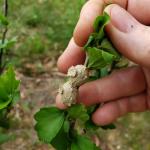 Potter Wasps: These insects in the subfamily Eumeninae (the potter and mason wasps; Order Hymenoptera, Family Vespidae) are the potters of the wasp world! These amazing creatures create small, round, almost jug-like nests from clay, attached to leaves, twigs, railings, and sometimes, our homes. They cause no damage to plants or structures. These wasps painstakingly gather water, mix it with dry soil, and create tiny pots that range from ¼ - 6/16 of an inch in diameter. Upon completion of the creation of her pot, the female wasp lays a single egg inside the nest she’s just created. The female wasp will then provision the pot with a paralyzed beetle larva or other caterpillar (that she has stung to paralyze) and then seals this insect (food for her young) inside the pot with her developing egg. The larval wasp hatches, consumes the provisioned food, and eventually pupates, to emerge from the pot as a fully-grown wasp. These wasps are not known to be aggressive. They are also providing a beneficial service by feeding certain pest caterpillars to their young. Therefore, if you find potter wasp pots, appreciate them for all of the hard work it took for that female to create it and preserve them!
Potter Wasps: These insects in the subfamily Eumeninae (the potter and mason wasps; Order Hymenoptera, Family Vespidae) are the potters of the wasp world! These amazing creatures create small, round, almost jug-like nests from clay, attached to leaves, twigs, railings, and sometimes, our homes. They cause no damage to plants or structures. These wasps painstakingly gather water, mix it with dry soil, and create tiny pots that range from ¼ - 6/16 of an inch in diameter. Upon completion of the creation of her pot, the female wasp lays a single egg inside the nest she’s just created. The female wasp will then provision the pot with a paralyzed beetle larva or other caterpillar (that she has stung to paralyze) and then seals this insect (food for her young) inside the pot with her developing egg. The larval wasp hatches, consumes the provisioned food, and eventually pupates, to emerge from the pot as a fully-grown wasp. These wasps are not known to be aggressive. They are also providing a beneficial service by feeding certain pest caterpillars to their young. Therefore, if you find potter wasp pots, appreciate them for all of the hard work it took for that female to create it and preserve them!
Insects and Other Arthropods of Public Health Concern:
- Deer Tick/Blacklegged Tick: Check out the archived FREE TickTalk with TickReport webinars available here: https://ag.umass.edu/landscape/education-events/webinars . Previous webinars including information about deer ticks and associated diseases, ticks and personal protection, and updates from the Laboratory of Medical Zoology are archived at the link above.
The next webinar will be held on July 8, 2020: The Facts about Powassan Virus
Dr. Stephen Rich, Professor of Microbiology and Director of the UMass Laboratory of Medical Zoology, and Dr. Saravanan Thangamani, Professor of Microbiology and Immunology at Upstate Medical University in Syracuse, NY discuss what is currently known about tick-borne viruses, including Powassan virus. Dr. Thangamani studies the serosurveillance of vector-borne (tick and mosquito) diseases including the effect of co-infection on the clinical outcome of Lyme disease and Powassan encephalitis.
Ixodes scapularis nymphs (immatures) are active, and may be encountered at this time, through August. Nymphs will have already taken a blood meal, and therefore can be infected with disease causing pathogens. It is important to protect yourself against ticks and be especially vigilant for tiny, difficult to see nymphs. For images of all deer tick life stages, along with an outline of the diseases they carry, visit: http://www.tickencounter.org/tick_identification/deer_tick .
Anyone working in the yard and garden should be aware that there is the potential to encounter deer ticks. The deer tick or blacklegged tick can transmit Lyme disease, human babesiosis, human anaplasmosis, and other diseases. Preventative activities, such as daily tick checks, wearing appropriate clothing, and permethrin treatments for clothing (according to label instructions) can aid in reducing the risk that a tick will become attached to your body. If a tick cannot attach and feed, it will not transmit disease. For more information about personal protective measures, visit: http://www.tickencounter.org/prevention/protect_yourself .
Due to unprecedented circumstances of the global pandemic, the University of Massachusetts has mandated work furloughs for all university staff. Unfortunately, this order comes at the annual peak of tick activity, and hence TickReport testing will not be available during the furlough. Effective at 11:59PM on 3-June-2020, until 12:01AM on 19-June-2020, TickReport will not be accepting new orders. For a full statement from TickReport, please visit: https://www.tickreport.com . Please contact TickReport with further questions and updates on the status of their service.
The UMass Laboratory of Medical Zoology does not give medical advice, nor are the results of their tests diagnostic of human disease. Transmission of a pathogen from the tick to you is dependent upon how long the tick had been feeding, and each pathogen has its own transmission time. TickReport is an excellent measure of exposure risk for the tick (or ticks) that you send in to be tested. Feel free to print out and share your TickReport with your healthcare provider.
- Mosquitoes: According to the Massachusetts Bureau of Infectious Disease and Laboratory Science and the Department of Public Health, there are at least 51 different species of mosquito found in Massachusetts. Mosquitoes belong to the Order Diptera (true flies) and the Family Culicidae (mosquitoes). As such, they undergo complete metamorphosis, and possess four major life stages: egg, larva, pupa, and adult. Adult mosquitoes are the only stage that flies and many female mosquitoes only live for 2 weeks (although the life cycle and timing will depend upon the species). Only female mosquitoes bite to take a blood meal, and this is so they can make eggs. Mosquitoes need water to lay their eggs in, so they are often found in wet or damp locations and around plants. Different species prefer different habitats. It is possible to be bitten by a mosquito at any time of the day, and again timing depends upon the species. Many are particularly active from just before dusk, through the night, and until dawn. Mosquito bites are not only itchy and annoying, but they can be associated with greater health risks. Certain mosquitoes vector pathogens that cause diseases such as West Nile virus (WNV) and eastern equine encephalitis (EEE).
For more information about mosquitoes in Massachusetts, visit: https://www.mass.gov/service-details/mosquitoes-in-massachusetts
There are ways to protect yourself against mosquitoes, including wearing long-sleeved shirts and long pants, keeping mosquitoes outside by using tight-fitting window and door screens, and using insect repellents as directed. Products containing the active ingredients DEET, permethrin, IR3535, picaridin, and oil of lemon eucalyptus provide protection against mosquitoes.
For more information about mosquito repellents, visit: https://www.mass.gov/service-details/mosquito-repellents and https://www.cdc.gov/features/stopmosquitoes
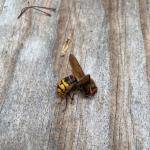
 Wasps/Hornets: Many are noticing the spring time “awakening” of various species of wasps/hornets in Massachusetts at this time. Many wasps are predators of other arthropods, including pest insects such as certain caterpillars that feed on trees and shrubs. Adult wasps hunt prey and bring it back to their nest where young are being reared, as food for the immature wasps. A common such example are the paper wasps (Polistes spp.) who rear their young on chewed up insects. They may be seen searching plants for caterpillars and other soft-bodied larvae to feed their young. Paper wasps can sting, and will defend their nests, which are open-celled paper nests that are not covered with a papery “envelope”. These open-celled nests may be seen hanging from eaves or other outdoor building structures. Aerial yellow jackets and hornets create large aerial nests that are covered with a papery shell or “envelope”. Common yellow jacket species include those in the genus Vespula. Dolichovespula maculata is commonly known as the baldfaced hornet, although it is not a true hornet. The European hornet (Vespa crabro) is three times the size of a yellow jacket and may be confused for the Asian giant hornet (Vespa mandarinia). The European hornet is known to Massachusetts, but the Asian giant hornet is not. If you are concerned that you have found or photographed an Asian giant hornet, please report it here: https://massnrc.org/pests/report.aspx . A helpful ID tool, although developed for Texas by the USDA, depicts common look-a-like species that we also have in MA that can be confused for the Asian giant hornet and is found here: https://agrilife.org/lubbock/files/2020/05/Asian_Giant_Hornet_Look-alikes_101_Xanthe_Shirley.pdf Paper wasps and aerial yellowjackets overwinter as fertilized females (queens) and a single female produces a new nest annually in the late spring. Nests are abandoned at the end of the season. It is this annual behavior of queens starting new nests, laying eggs, and rearing new wasps to assist in colony/nest development that may lead people to believe that wasp/yellow jacket numbers are high at this time of year. While populations may fluctuate and insect survival may have been aided by a mild winter (although that is not always true for all species), it is difficult to tell if these insects are more numerous this year, or just that they are more noticeable now that nest construction and brood development are under way for the season. Either way, some people are allergic to stinging insects, so care should be taken around wasp/hornet nests. Unlike the European honeybee (Apis mellifera), wasps and hornets do not have barbed stingers, and therefore can sting repeatedly when defending their nests. It is best to avoid their nests, and if that cannot be done and assistance is needed to remove them, consult a professional.
Wasps/Hornets: Many are noticing the spring time “awakening” of various species of wasps/hornets in Massachusetts at this time. Many wasps are predators of other arthropods, including pest insects such as certain caterpillars that feed on trees and shrubs. Adult wasps hunt prey and bring it back to their nest where young are being reared, as food for the immature wasps. A common such example are the paper wasps (Polistes spp.) who rear their young on chewed up insects. They may be seen searching plants for caterpillars and other soft-bodied larvae to feed their young. Paper wasps can sting, and will defend their nests, which are open-celled paper nests that are not covered with a papery “envelope”. These open-celled nests may be seen hanging from eaves or other outdoor building structures. Aerial yellow jackets and hornets create large aerial nests that are covered with a papery shell or “envelope”. Common yellow jacket species include those in the genus Vespula. Dolichovespula maculata is commonly known as the baldfaced hornet, although it is not a true hornet. The European hornet (Vespa crabro) is three times the size of a yellow jacket and may be confused for the Asian giant hornet (Vespa mandarinia). The European hornet is known to Massachusetts, but the Asian giant hornet is not. If you are concerned that you have found or photographed an Asian giant hornet, please report it here: https://massnrc.org/pests/report.aspx . A helpful ID tool, although developed for Texas by the USDA, depicts common look-a-like species that we also have in MA that can be confused for the Asian giant hornet and is found here: https://agrilife.org/lubbock/files/2020/05/Asian_Giant_Hornet_Look-alikes_101_Xanthe_Shirley.pdf Paper wasps and aerial yellowjackets overwinter as fertilized females (queens) and a single female produces a new nest annually in the late spring. Nests are abandoned at the end of the season. It is this annual behavior of queens starting new nests, laying eggs, and rearing new wasps to assist in colony/nest development that may lead people to believe that wasp/yellow jacket numbers are high at this time of year. While populations may fluctuate and insect survival may have been aided by a mild winter (although that is not always true for all species), it is difficult to tell if these insects are more numerous this year, or just that they are more noticeable now that nest construction and brood development are under way for the season. Either way, some people are allergic to stinging insects, so care should be taken around wasp/hornet nests. Unlike the European honeybee (Apis mellifera), wasps and hornets do not have barbed stingers, and therefore can sting repeatedly when defending their nests. It is best to avoid their nests, and if that cannot be done and assistance is needed to remove them, consult a professional.
Woody ornamental insect and non-insect arthropod pests to consider, a selected few:

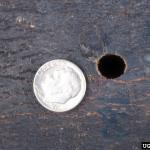
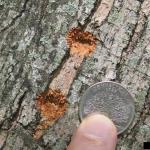 Asian Longhorned Beetle: (Anoplophora glabripennis, ALB) was recently detected for the first time in South Carolina. Asian longhorned beetle eradication programs currently exist in Massachusetts, New York, and Ohio. A homeowner is responsible for finding, reporting, and making officials aware of the infestation in South Carolina. Great job!
Asian Longhorned Beetle: (Anoplophora glabripennis, ALB) was recently detected for the first time in South Carolina. Asian longhorned beetle eradication programs currently exist in Massachusetts, New York, and Ohio. A homeowner is responsible for finding, reporting, and making officials aware of the infestation in South Carolina. Great job!
The U.S. Department of Agriculture’s (USDA) Animal and Plant Health Inspection Service (APHIS) and the Clemson University’s Department of Plant Industry (DPI) are inspecting trees in Hollywood, South Carolina following the detection and identification of the Asian longhorned beetle (ALB).
On May 29, a homeowner in Hollywood, South Carolina contacted DPI to report they found a dead beetle on their property and suspected it was ALB. A DPI employee collected the insect the same day and conducted a preliminary survey of the trees on the property. Clemson’s Plant and Pest Diagnostic Clinic provided an initial identification of ALB, and on June 4, APHIS’ National Identification Services confirmed the insect. On June 11, APHIS and DPI inspectors confirmed that one tree on the property is infested, and a second infested tree was found on an adjacent property. For more information, visit: https://www.aphis.usda.gov/aphis/newsroom/stakeholder-info/sa_by_date/sa-2020/sa-06/alb-sc .
This is a perfectly timed reminder for us to remain vigilant, and report any suspicious beetles or damage to trees, especially maples. Asian longhorned beetle infests 12 genera of trees, however maples are preferred hosts.
Look for signs of an ALB infestation which include perfectly round exit holes (about the size of a dime), shallow oval or round scars in the bark where a female has chewed an egg site, or sawdust-like frass (excrement) on the ground nearby host trees or caught in between branches. Be advised that other, native insects may create perfectly round exit holes or sawdust-like frass, which can be confused with signs of ALB activity.
The regulated area for Asian longhorned beetle is 110 miles2 encompassing Worcester, Shrewsbury, Boylston, West Boylston, and parts of Holden and Auburn. If you believe you have seen damage caused by this insect, such as exit holes or egg sites, on susceptible host trees like maple, please call the Asian Longhorned Beetle Eradication Program office in Worcester, MA at 508-852-8090 or toll free at 1-866-702-9938.
To report an Asian longhorned beetle find online or compare it to common insect look-alikes, visit: http://massnrc.org/pests/albreport.aspx or https://www.aphis.usda.gov/pests-diseases/alb/report .
- White Spotted Pine Sawyer (WSPS): Monochamus scutellatus adults can emerge in late May throughout July, depending on local temperatures. The Asian Longhorned Beetle Eradication Program reports that white spotted pine sawyer adult beetle activity has increased recently. This is a native insect in Massachusetts and is usually not a pest. Larvae develop in weakened or recently dead conifers, particularly eastern white pine (Pinus strobus). However, the white spotted pine sawyer looks very similar to the invasive Asian Longhorned Beetle, Anoplophora glabripennis, ALB. ALB adults do not emerge in Massachusetts until July and August. Beginning in July, look for the key difference between WSPS and ALB adults, which is a white spot in the top center of the wing covers (the scutellum) on the back of the beetle. White spotted pine sawyer will have this white spot, whereas Asian longhorned beetle will not. Both insects can have other white spots on the rest of their wing covers; however, the difference in the color of the scutellum is a key characteristic. See the Asian longhorned beetle entry above for more information about that non-native insect.
- Arborvitae Leafminer: In New England and eastern Canada, four species of leafminers are known to infest arborvitae. These include Argyresthia thuiella, A. freyella, A. aureoargentella, and Coleotechnites thujaella. The arborvitae leafminer, A. thuiella, is the most abundant of these and has the greatest known range when compared to the others. (It is also found in the Mid-Atlantic States and as far west as Missouri). Moths of this species appear from mid-June to mid-July and lay their eggs. The damage caused by all of these species is nearly identical. Trees, however, have been reported to lose up to 80% of their foliage due to arborvitae leafminer and still survive. At least 27 species of parasites have been reported as natural enemies of arborvitae leafminers, the most significant of which may be a parasitic wasp (Pentacnemus bucculatricis). Arborvitae leafminer damage causes the tips of shoots and foliage to turn yellow and brown. If infestations are light, prune out infested tips.
- Azalea Bark Scale: Eriococcus azaleae was discovered in CT in 1917 and has since been reported in other states. It is found on the bark of twigs and stems and commonly settles in branch crotches. It has been reported on azalea, rhododendron, andromeda, and others. Female scales are approximately 2-3 mm. in length and covered in a white, waxy coating. The females are purple in color and may resemble a mealybug, although they are a soft or felt scale. These females have overwintered and are going to lay eggs which will hatch into crawlers toward the end of June through mid-July. Crawlers will settle into branch crotches, bark crevices, or on the axils of leaves. There is a parasitic wasp that will attack these insects. When high in number, these scales can cause yellowing of the foliage and their sugary excrement can lead to the promotion of sooty mold. Because these are soft scales, they may be targeted with horticultural oils or insecticidal soaps while observing label instructions to prevent phytotoxicity.
- Azalea Sawflies: There are a few species of sawflies that impact azaleas. Johnson and Lyon's Insects that Feed on Trees and Shrubs mentions three of them. Amauronematus azaleae was first reported in New Hampshire in 1895 and is likely found in most of New England. Adults of this species are black with some white markings and wasp-like. Generally green larvae feed mostly on mollis hybrid azaleas. Remember, sawfly caterpillars have at least enough abdominal prolegs to spell “sawfly” (so 6 or more prolegs). Adults are present in May, and females lay their eggs and then larvae hatch and feed through the end of June. There is one generation per year. Nematus lipovskyi has been reared from swamp azalea (Rhododendron viscosum). Adults of that species have been collected in April (in states to the south) and May (in New England) and larval feeding is predominantly in late April and May in Virginia and June in New England. One generation of this species occurs per year, and most mollis hybrid azaleas can be impacted. A third species, Arge clavicornis, is found as an adult in July and lays its eggs in leaf edges in rows. Larvae are present in August and September. Remember, Bacillus thuringiensis Kurstaki does not manage sawflies.
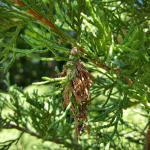 Bagworm: Thyridopteryx ephemeraeformis is a native species of moth whose larvae construct bag-like coverings over themselves with host plant leaves and twigs. This insect overwinters in the egg stage, within the bags of deceased females from last season. Eggs may hatch and young larvae are observed feeding around mid-June, or roughly between 600-900 GDD’s. Remove and destroy overwintering bags before June. In certain areas across MA in 2019, increased populations of bagworms were observed and reported. More information can be found here: https://ag.umass.edu/landscape/fact-sheets/bagworm
Bagworm: Thyridopteryx ephemeraeformis is a native species of moth whose larvae construct bag-like coverings over themselves with host plant leaves and twigs. This insect overwinters in the egg stage, within the bags of deceased females from last season. Eggs may hatch and young larvae are observed feeding around mid-June, or roughly between 600-900 GDD’s. Remove and destroy overwintering bags before June. In certain areas across MA in 2019, increased populations of bagworms were observed and reported. More information can be found here: https://ag.umass.edu/landscape/fact-sheets/bagworm- Boxwood Leafminer: Monarthropalpus flavus partly grown fly larvae overwinter in the leaves of susceptible boxwood. Yellowish mines may be noticeable on the undersides of leaves. This insect grows rapidly in the spring, transforming into an orange-colored pupa. After pupation, adults will emerge and white colored pupal cases may hang down from the underside of leaves where adults have emerged. Adults may be observed swarming hosts between 300-650 GDD’s, or roughly the end of May through June. Most cultivars of Buxus sempervirens and B. microphylla are thought to be susceptible. If installing new boxwoods this spring, resistant cultivars such as ‘Vardar Valley’ and ‘Winter Gem’ are good choices at sites where this insect has been a problem.
- Boxwood Mite: Eurytetranychus buxi overwinter as tiny eggs on boxwood leaves and hatch mid-spring. These mites are tiny (about the size of a period) and difficult to detect. Feeding may cause plants to appear off-color. If management is deemed necessary, the timing for treatment may be between 245-600 GDD’s.
- Cottony Taxus Scale: Pulvinaria floccifera, also referred to as the cottony camellia scale, utilizes such hosts as taxus, camellia, holly, hydrangea, Japanese maple, euonymus, magnolia, and jasmine, among others. Females have laid the long, narrow, white and fluted egg sac that makes them much more noticeable. Eggs will hatch over an extended period of 6 weeks and crawlers may be treated between 802-1388 GDD’s. This insect can cause the host to appear off-color. They also produce honeydew which promotes sooty mold growth. Dieback is not common with this insect. Target the underside of the foliage. Horticultural oil, neem oil, and insecticidal soaps may be used to manage these soft scales. Reduced risk options help preserve natural enemies.
- Dogwood Borer: Synanthedon scitula is a species of clearwing moth whose larvae bore not only into dogwood (Cornus), but hosts also include flowering cherry, chestnut, apple, mountain ash, hickory, pecan, willow, birch, bayberry, oak, hazel, myrtle, and others. Kousa dogwood appear to be resistant to this species. Signs include the sloughing of loose bark, brown frass, particularly near bark cracks and wounds, dead branches, and adventitious growth. The timing of adult emergence can be expected when dogwood flower petals are dropping and weigela begins to bloom. Adult moth flights continue from then until September. Emergence in some hosts (ex. apple) appears to be delayed, but this differs depending upon the location in this insect’s range. Eggs are laid singly, or in small groups, on smooth and rough bark. Female moths preferentially lay eggs near wounded bark. After hatch, larvae wander until they find a suitable entrance point into the bark. This includes wounds, scars, or branch crotches. This insect may also be found in twig galls caused by other insects or fungi. Larvae feed on phloem and cambium. Fully grown larvae are white with a light brown head and approx. ½ inch long. Pheromone traps and lures are useful for determining the timing of adult moth emergence and subsequent management.
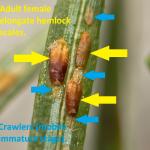 Elongate Hemlock Scale: Fiorinia externa is found on eastern, Carolina, and Japanese hemlock, as well as yew, spruce, and fir. The elongate hemlock scale may overwinter in various life stages, and overlap of many developmental stages at any given time can be observed throughout much of the season. Dormant oil applications for this pest can occur according to label instructions in April, roughly between 7-120 GDD’s. Treatments for the crawler, or mobile, stage of this insect may be made in late May through mid-June, or between 360-700 GDD’s, base 50°F. Nitrogen fertilizer applications may make elongate hemlock scale infestations worse.
Elongate Hemlock Scale: Fiorinia externa is found on eastern, Carolina, and Japanese hemlock, as well as yew, spruce, and fir. The elongate hemlock scale may overwinter in various life stages, and overlap of many developmental stages at any given time can be observed throughout much of the season. Dormant oil applications for this pest can occur according to label instructions in April, roughly between 7-120 GDD’s. Treatments for the crawler, or mobile, stage of this insect may be made in late May through mid-June, or between 360-700 GDD’s, base 50°F. Nitrogen fertilizer applications may make elongate hemlock scale infestations worse.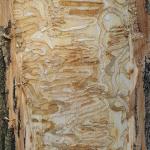
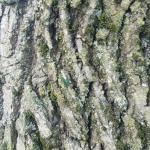
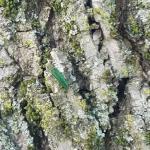 Emerald Ash Borer: (Agrilus planipennis, EAB) Since March 2020, the Massachusetts Department of Conservation and Recreation has confirmed a total of at least 116 communities in Massachusetts that have known populations of emerald ash borer. A map of these locations across the state may be found here: https://ag.umass.edu/fact-sheets/emerald-ash-borer .
Emerald Ash Borer: (Agrilus planipennis, EAB) Since March 2020, the Massachusetts Department of Conservation and Recreation has confirmed a total of at least 116 communities in Massachusetts that have known populations of emerald ash borer. A map of these locations across the state may be found here: https://ag.umass.edu/fact-sheets/emerald-ash-borer .
This wood-boring beetle readily attacks ash (Fraxinus spp.) including white, green, and black ash and has also been found developing in white fringe tree (Chionanthus virginicus) and has been reported in cultivated olive (Olea europaea). Adult insects of this species will not be present at this time of year. Signs of an EAB infested tree may include (at this time) D-shaped exit holes in the bark (from adult emergence in previous years), “blonding” or lighter coloration of the ash bark from woodpecker feeding (chipping away of the bark as they search for larvae beneath), and serpentine galleries visible through splits in the bark, from larval feeding beneath. Positive identification of an EAB-infested tree may not be possible with these signs individually on their own.
For further information about this insect, please visit: https://ag.umass.edu/fact-sheets/emerald-ash-borer . If you believe you have located EAB-infested ash trees, particularly in an area of Massachusetts not identified on the map provided, please report here: http://massnrc.org/pests/pestreports.htm .
- Eriophyid Mites: these insect relatives are known to create different types of leaf galls on certain host plants. The crimson erineum mite or Eriophyes elongates is one of my favorites. This insect can be found on the leaves of sugar maple, creating felt patches on the upper leaf surface that appear pink, or a deep crimson red. The crimson erineum mite was seen on sugar maple in Chesterfield, MA on 5/28/2020. Like the vast majority of leaf galls, the crimson erineum mite does not cause significant injury to its host plant, and therefore management is not necessary.
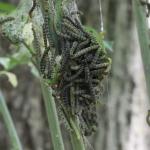 Euonymus Caterpillar: Yponomeuta cagnagella is of European origin and widespread in distribution throughout Europe. It was first reported in North America in Ontario in 1967. The euonymus caterpillars (larvae) feed in groups and envelop the foliage of the host plant in webs as they feed. Hosts include: Euonymus europaeus (tree form), E. kiautschovicus, E. alatus, and E. japonicus. Mature caterpillars are just under an inch in length, creamy yellow-gray in color with black spots and a black head capsule. By late June, these larvae pupate in white, oval-shaped cocoons which are typically oriented together vertically either on host plants or non-hosts in the area. Cocoons can be found in cracks and crevices, or webbed together leaves. The adult moth emerges in late June in most locations. The adult female secretes a gummy substance over her eggs which will harden, making them even more difficult to see. Eggs hatch by mid-August, at which time the tiny larvae prepare to overwinter beneath their eggshell-like covering. These larvae are inactive until the following year, when caterpillars group together to feed on newly emerging leaves, creating a mess of webs as they feed. There is one generation per year. Plants may be partially or entirely defoliated. Management of young, actively feeding caterpillars with Bacillus thuringiensis is possible if deemed necessary, however many species of Euonymus are considered invasive themselves.
Euonymus Caterpillar: Yponomeuta cagnagella is of European origin and widespread in distribution throughout Europe. It was first reported in North America in Ontario in 1967. The euonymus caterpillars (larvae) feed in groups and envelop the foliage of the host plant in webs as they feed. Hosts include: Euonymus europaeus (tree form), E. kiautschovicus, E. alatus, and E. japonicus. Mature caterpillars are just under an inch in length, creamy yellow-gray in color with black spots and a black head capsule. By late June, these larvae pupate in white, oval-shaped cocoons which are typically oriented together vertically either on host plants or non-hosts in the area. Cocoons can be found in cracks and crevices, or webbed together leaves. The adult moth emerges in late June in most locations. The adult female secretes a gummy substance over her eggs which will harden, making them even more difficult to see. Eggs hatch by mid-August, at which time the tiny larvae prepare to overwinter beneath their eggshell-like covering. These larvae are inactive until the following year, when caterpillars group together to feed on newly emerging leaves, creating a mess of webs as they feed. There is one generation per year. Plants may be partially or entirely defoliated. Management of young, actively feeding caterpillars with Bacillus thuringiensis is possible if deemed necessary, however many species of Euonymus are considered invasive themselves.
Want to see euonymus caterpillars in action?! I bet you’ve never seen so many of these caterpillars in one place! Check out Episode 3 of InsectXaminer: https://ag.umass.edu/landscape/education-events/insectxaminer .
- Euonymus Scale: Unaspis euonymi is an armored scale that can be found on euonymus, holly, bittersweet, and pachysandra. This insect can cause yellow spotting on leaves, dieback, and distorted bark. Dormant oil applications can be made between 35-120 GDD’s or roughly from mid-April to early-May. For crawlers, early June timing is suggested between 533-820 GDD’s. (Eggs begin to hatch in early June.)
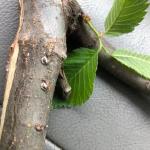 European Elm Scale: Gossyparia spuria is a type of felt scale and was reported to UMass Extension as active in Quincy, MA on 6/3/20. First noted in New York in 1884, this non-native scale is now widespread in North America and is found on native and European elms, but also rarely on hackberry and Zelkova. This insect can cause yellowing of foliage, premature leaf drop, and eventually dieback on its host. Honeydew and thus sooty mold are produced. The females observed in Quincy, MA have produced a ring of white fibers around their black, oval bodies. By the end of June, these females will lay eggs that hatch into bright yellow crawlers, which will disperse to the midrib and leaf veins on the underside of elm leaves where they will remain to feed. Crawlers are tiny and magnification is necessary to observe. Natural enemies such as parasitic wasps and predatory insects have been reported as successful in managing this insect.
European Elm Scale: Gossyparia spuria is a type of felt scale and was reported to UMass Extension as active in Quincy, MA on 6/3/20. First noted in New York in 1884, this non-native scale is now widespread in North America and is found on native and European elms, but also rarely on hackberry and Zelkova. This insect can cause yellowing of foliage, premature leaf drop, and eventually dieback on its host. Honeydew and thus sooty mold are produced. The females observed in Quincy, MA have produced a ring of white fibers around their black, oval bodies. By the end of June, these females will lay eggs that hatch into bright yellow crawlers, which will disperse to the midrib and leaf veins on the underside of elm leaves where they will remain to feed. Crawlers are tiny and magnification is necessary to observe. Natural enemies such as parasitic wasps and predatory insects have been reported as successful in managing this insect.
- Fall Webworm: Hyphantria cunea is native to North America and Mexico. It is now considered a world-wide pest, as it has spread throughout much of Europe and Asia. (For example, it was introduced accidentally into Hungary from North America in the 1940’s.) Hosts include nearly all shade, fruit, and ornamental trees except conifers. In the USA, at least 88 species of trees are hosts for these insects, while in Europe at least 230 species are impacted. In the past history of this pest, it was once thought that the fall webworm was a two-species complex. It is now thought that H. cunea has two color morphs – one black headed and one red headed. These two color forms differ not only in the coloration of the caterpillars and the adults, but also in their behaviors. Caterpillars may go through at least 11 molts, each stage occurring within a silken web they produce over the host. When alarmed, all caterpillars in the group will move in unison in jerking motions that may be a mechanism for self-defense. Depending upon the location and climate, 1-4 generations of fall webworm can occur per year. Fall webworm adult moths lay eggs on the underside of the leaves of host plants in the spring. These eggs hatch in late June or early July depending on climate. Young larvae feed together in groups on the undersides of leaves, first skeletonizing the leaf and then enveloping other leaves and eventually entire branches within their webs. Webs are typically found on the terminal ends of branches. All caterpillar activity occurs within this tent, which becomes filled with leaf fragments, cast skins, and frass. Fully grown larvae then wander from the webs and pupate in protected areas such as the leaf litter where they will remain for the winter. Adult fall webworm moths emerge the following spring/early summer to start the cycle over again. 50+ species of parasites and 36+ species of predators are known to attack fall webworm in North America. Fall webworms typically do not cause extensive damage to their hosts. Nests may be an aesthetic issue for some. If in reach, small fall webworm webs may be pruned out of trees and shrubs and destroyed. Do not set fire to H. cunea webs when they are still attached to the host plant.

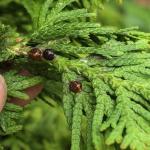 Fletcher Scale: Parthenolecanium fletcheri is a soft scale pest of yew, juniper, and arborvitae. Feeding scales, especially on yew, result in honeydew and sooty mold, needle yellowing, and at times, premature needle drop. There is one generation per year. Overwintered second instar nymphs can be targeted between 38-148 GDD’s, base 50°F. Nymphs develop and adult females lay eggs (on average 500-600) in May that hatch by June. Dead females conceal egg masses beneath. Crawlers migrate short distances to branches and may be concentrated on certain branches of a particular plant.
Fletcher Scale: Parthenolecanium fletcheri is a soft scale pest of yew, juniper, and arborvitae. Feeding scales, especially on yew, result in honeydew and sooty mold, needle yellowing, and at times, premature needle drop. There is one generation per year. Overwintered second instar nymphs can be targeted between 38-148 GDD’s, base 50°F. Nymphs develop and adult females lay eggs (on average 500-600) in May that hatch by June. Dead females conceal egg masses beneath. Crawlers migrate short distances to branches and may be concentrated on certain branches of a particular plant.
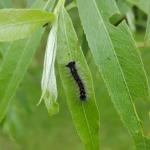 Gypsy Moth:(Lymantria dispar) thanks to the gypsy moth caterpillar killing fungus, Entomophaga maimaiga, the recent outbreak of gypsy moth in Massachusetts has come to an end! Most locations in Massachusetts will not see damaging or even noticeable populations of this insect in 2020. However, that does not mean the occasional egg mass won’t be seen in certain areas of the state. Egg hatch was observed and reported with photo evidence in Shelburne Falls, MA on 5/4/2020.Shadbush (Amelanchier spp.) was reported as in full bloom at the same time in that area. A young gypsy moth caterpillar was seen feeding on willow in Chesterfield, MA on 6/3/20, despite the relative lack of overwintering gypsy moth egg masses in the area. The impact of gypsy moth in this particular hilltown in Hampshire County has been negligible.
Gypsy Moth:(Lymantria dispar) thanks to the gypsy moth caterpillar killing fungus, Entomophaga maimaiga, the recent outbreak of gypsy moth in Massachusetts has come to an end! Most locations in Massachusetts will not see damaging or even noticeable populations of this insect in 2020. However, that does not mean the occasional egg mass won’t be seen in certain areas of the state. Egg hatch was observed and reported with photo evidence in Shelburne Falls, MA on 5/4/2020.Shadbush (Amelanchier spp.) was reported as in full bloom at the same time in that area. A young gypsy moth caterpillar was seen feeding on willow in Chesterfield, MA on 6/3/20, despite the relative lack of overwintering gypsy moth egg masses in the area. The impact of gypsy moth in this particular hilltown in Hampshire County has been negligible.
Gypsy moth has been in Massachusetts since the 1860's. This invasive insect from Europe often goes unnoticed, thanks to population regulation provided by the entomopathogenic fungus, E. maimaiga, as well as a NPV virus specific to gypsy moth caterpillars. (And to a lesser extent many other organisms, including other insects, small mammals, and birds who feed on gypsy moth.) However, if environmental conditions do not favor the life cycle of the fungus, outbreaks of gypsy moth caterpillars are possible. (Such as most recently from 2015-2018, with a peak in the gypsy moth population in 2017 in Massachusetts.)
Missing gypsy moth already? Check out Episode 1 of InsectXaminer to reminisce about the 2015-2018 outbreak of this insect: https://ag.umass.edu/landscape/education-events/insectxaminer
- Hemlock Looper: Two species of geometrid moths in the genus Lambdina are native insects capable of defoliating eastern hemlock, balsam fir, and white spruce. Adult moths lay their eggs on the trunk and limbs of hosts in September and October, and eggs will hatch by late May or early June. (L. fiscellaria caterpillars may be active between 448-707 GDD’s.) Monitor susceptible hosts for small, inch-worm like caterpillars. Where populations are low, no management is necessary. Hemlock loopers have several effective natural enemies.
- Hemlock Woolly Adelgid: Adelges tsugae is present on eastern and Carolina hemlock. The overwintering hemlock woolly adelgid generation (sistens) is present through mid-spring and produces the spring generation (progrediens) which will be present from early spring through mid-summer. HWA, unlike many other insects, does most of its feeding over the winter. Eggs may be found in woolly masses at the base of hemlock needles beginning in mid-March. Each woolly mass is created by a female who may then lay 50-300 eggs. Eggs hatch and crawlers may be found from mid-March through mid-July. Infested trees may be treated with foliar sprays in late April to early May, using Japanese quince as a phenological indicator. Systemic applications may be made in the spring and fall, or when soil conditions are favorable for translocation to foliage. Nitrogen fertilizer applications may make hemlock woolly adelgid infestations worse.
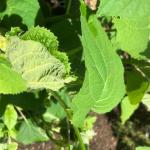
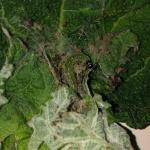 Hydrangea Leaftier: Olethreutes ferriferana is a moth in the Family Tortricidae whose caterpillars use silk applied to the edges of two newly expanding hydrangea leaves to tie them together to create an envelope-like structure within which they feed. These leaf-envelopes tend to occur near the tips of plant stems and can be very obvious. As a result, the two tied leaves may not fully expand when compared to healthy, not impacted leaves. Caterpillars are green and partially transparent with a black head capsule and a black thoracic shield which is found on the top of the body segment located directly behind the head. It is likely that caterpillars will soon be pupating. Pupation is thought to occur in the ground nearby host plants, so the insect drops to the ground to pupate where it overwinters. Adults are found in the spring and are small white and brown moths. Eggs are laid on branch tips of various species of hydrangea. Only one generation is known per year. This insect, although creating visible and interesting damage to hydrangea, is not usually considered to be a serious pest – although occasional localized problematic populations have been reported. Removing leaf-envelopes in the early spring or pinching them to kill the caterpillar within can help reduce populations on individual plants.
Hydrangea Leaftier: Olethreutes ferriferana is a moth in the Family Tortricidae whose caterpillars use silk applied to the edges of two newly expanding hydrangea leaves to tie them together to create an envelope-like structure within which they feed. These leaf-envelopes tend to occur near the tips of plant stems and can be very obvious. As a result, the two tied leaves may not fully expand when compared to healthy, not impacted leaves. Caterpillars are green and partially transparent with a black head capsule and a black thoracic shield which is found on the top of the body segment located directly behind the head. It is likely that caterpillars will soon be pupating. Pupation is thought to occur in the ground nearby host plants, so the insect drops to the ground to pupate where it overwinters. Adults are found in the spring and are small white and brown moths. Eggs are laid on branch tips of various species of hydrangea. Only one generation is known per year. This insect, although creating visible and interesting damage to hydrangea, is not usually considered to be a serious pest – although occasional localized problematic populations have been reported. Removing leaf-envelopes in the early spring or pinching them to kill the caterpillar within can help reduce populations on individual plants.
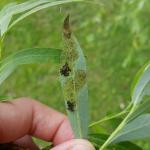 Imported Willow Leaf Beetle: Plagiodera versicolora adult beetles overwinter near susceptible hosts. Adult beetles will chew holes and notches in the leaves of willow once they become available. Imported willow leaf beetle adults were observed feeding and mating in Chesterfield, MA on 5/20/2020. Adults continue to feed and mate on 5/26/2020 and egg laying has been observed. Females lay yellow eggs in clusters on the undersides of leaves. While clusters of yellow eggs could still be found, tiny larvae have hatched and are beginning to skeletonize willow leaves, as observed on 6/3/20 in Chesterfield, MA. By 6/7/20, imported willow leave beetle larvae have grown larger and are skeletonizing willow leaves in Chesterfield, MA. Larvae are slug-like and bluish-green in color. They will feed in clusters and skeletonize the leaves. Most plants can tolerate the feeding from this insect, and foliage will appear brown. Repeated yearly feeding can be an issue, in which case management of the young larvae may be necessary. Take care with treatment in areas near water.
Imported Willow Leaf Beetle: Plagiodera versicolora adult beetles overwinter near susceptible hosts. Adult beetles will chew holes and notches in the leaves of willow once they become available. Imported willow leaf beetle adults were observed feeding and mating in Chesterfield, MA on 5/20/2020. Adults continue to feed and mate on 5/26/2020 and egg laying has been observed. Females lay yellow eggs in clusters on the undersides of leaves. While clusters of yellow eggs could still be found, tiny larvae have hatched and are beginning to skeletonize willow leaves, as observed on 6/3/20 in Chesterfield, MA. By 6/7/20, imported willow leave beetle larvae have grown larger and are skeletonizing willow leaves in Chesterfield, MA. Larvae are slug-like and bluish-green in color. They will feed in clusters and skeletonize the leaves. Most plants can tolerate the feeding from this insect, and foliage will appear brown. Repeated yearly feeding can be an issue, in which case management of the young larvae may be necessary. Take care with treatment in areas near water.- Lacebugs: Stephanitis spp. lacebugs such as S. pyriodes can cause severe injury to azalea foliage. S. rhododendri can be common on rhododendron and mountain laurel. S. takeyai has been found developing on Japanese Andromeda, Leucothoe, Styrax, and willow. Stephanitis spp. lace bug activity should be monitored through September. Before populations become too large, treat with a summer rate horticultural oil spray as needed. Be sure to target the undersides of the foliage in order to get proper coverage of the insects. Certain azalea and Andromeda cultivars may be less preferred by lace bugs.
- Lecanium Scales (Oak): Parthenolecanium quercifex overwinters as a second instar nymph on oak twigs. Females will begin feeding and mature in the spring, from mid-April to early May and eggs may be laid between late May and into June. Eggs hatch in June or early July and crawlers migrate to host plant leaves where they spend the summer and migrate as second instars back to host plant twigs in the fall. Mid-April to early-May (35-145 GDD’s) for dormant oil applications.
- Lilac Borer: Podosesia syringae is a clearwing moth pest of lilac, privet, fringetree, and ash. (It is also known as the ash borer, not to be confused with the emerald ash borer.) Adults mimic paper wasps. Larvae are wood-boring, and signs and symptoms include branch dieback, holes, and occasionally, sawdust-like frass accumulated on bark. Larvae bore into stems, trunks, and branches, chewing an irregularly shaped entrance hole. Peak adult moth flights may occur in the northern portion of this insect’s range in June and is usually over by August 1st. Pheromone traps can be used to time adult emergence. Adult females lay flattened, oval, and tan eggs that are deposited singly or in clusters on bark crevices, ridges, and sometimes smooth bark; but usually laid in or near wounds in the bark. On average, 395 eggs are laid by each female. After hatch, larvae chew into the bark and feed laterally and then vertically in phloem tissue. Larvae overwinter in tunnels in the final instar and resume feeding in the spring. Adults emerge through a round exit hole (4-5 mm. in diameter). This insectmay be targeted between 200-299 GDD’s, base 50°F.
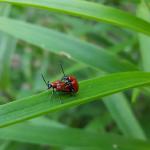 Lily Leaf Beetle: Lilioceris lilii adults overwinter in sheltered places. As soon as susceptible hosts such as Lilium spp. (Turk’s cap, tiger, Easter, Asiatic, and Oriental lilies) and Fritillaria spp. break through the ground, the adult lily leaf beetles are known to feed on the new foliage. (Note: daylilies are not hosts.)Typically, in May, mating will occur and each female will begin to lay 250-450 eggs in neat rows on the underside of the foliage. If there are only a few plants in the garden, hand picking and destroying overwintering adults can help reduce local garden-level populations at this time. For more information about this insect, visit the newly updated fact sheet: https://ag.umass.edu/landscape/fact-sheets/lily-leaf-beetle
Lily Leaf Beetle: Lilioceris lilii adults overwinter in sheltered places. As soon as susceptible hosts such as Lilium spp. (Turk’s cap, tiger, Easter, Asiatic, and Oriental lilies) and Fritillaria spp. break through the ground, the adult lily leaf beetles are known to feed on the new foliage. (Note: daylilies are not hosts.)Typically, in May, mating will occur and each female will begin to lay 250-450 eggs in neat rows on the underside of the foliage. If there are only a few plants in the garden, hand picking and destroying overwintering adults can help reduce local garden-level populations at this time. For more information about this insect, visit the newly updated fact sheet: https://ag.umass.edu/landscape/fact-sheets/lily-leaf-beetle
Want to learn more about lily leaf beetle’s life cycle and learn to recognize adults, larvae, and eggs? Take 3 minutes to watch Episode 2 of InsectXaminer, here: https://ag.umass.edu/landscape/education-events/insectxaminer .
- Magnolia Scale: Neolecanium cornuparvum overwinters as first instar nymphs which are elliptical, and dark slate gray in color and can usually be found on the undersides of 1 and 2 year old twigs. Nymphs may molt by late April or May and again by early June at which time the scales may be purple in color. Eventually nymphs secrete a white powdery layer of wax over their bodies.
- Rhododendron Borer: Synanthedon rhododendri is one of the smallest of the native clearwing moths. Rhododendrons are preferred hosts, although mountain laurel, and deciduous azaleas can be heavily infested, especially if they are planted in close proximity to rhododendrons. Injury may be first noticed in the fall (leaves lose their sheen, then become pale green, then olive, then chlorotic) and can look similar to drought stress. On branches that seem to be stunted, look at limb crotches, scars, and other irregularities for sawdust stuck on bark or on the ground beneath these areas. In late May and early June, holes may contain pupal shed skins extending halfway out. Moth emergence occurs in the late-spring, early-summer. After mating, female moths seek out suitable egg laying locations (preferring wounded areas or limb crotches). The female lays her eggs and dies. Eggs hatch and larvae tunnel into the inner bark where they feed in tunnels that become packed with reddish frass pellets. By late fall, larvae move to the sapwood where they overwinter and resume feeding by mid-March. Pupation occurs in the spring and there is one generation per year. Prune out and destroy infested branches before late May/June. Monitor for adults in mid-May (192-298 GDD’s, base 50°F).
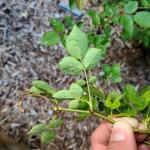
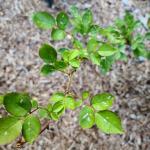 Roseslugs: Two species of sawfly can be found on the leaves of roses at this time. These small, caterpillar-like larvae will skeletonize the upper leaf surface and leave a “window-pane” like pattern behind. When present in large numbers, these insects are capable of defoliating their entire host. Management options include an insecticidal soap spray or a product containing spinosad. Roseslug sawflies were viewed in Hinsdale, MA on 6/7/2020.
Roseslugs: Two species of sawfly can be found on the leaves of roses at this time. These small, caterpillar-like larvae will skeletonize the upper leaf surface and leave a “window-pane” like pattern behind. When present in large numbers, these insects are capable of defoliating their entire host. Management options include an insecticidal soap spray or a product containing spinosad. Roseslug sawflies were viewed in Hinsdale, MA on 6/7/2020.
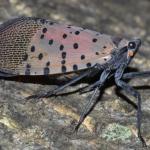 Spotted Lanternfly: (Lycorma delicatula, SLF) is not known to occur in Massachusetts landscapes (no established populations are known in MA at this time). However, due to the great ability of this insect to hitchhike using human-aided movement, it is important that we remain vigilant in Massachusetts and report any suspicious findings. Spotted lanternfly reports can be sent here:https://massnrc.org/pests/slfreport.aspx
Spotted Lanternfly: (Lycorma delicatula, SLF) is not known to occur in Massachusetts landscapes (no established populations are known in MA at this time). However, due to the great ability of this insect to hitchhike using human-aided movement, it is important that we remain vigilant in Massachusetts and report any suspicious findings. Spotted lanternfly reports can be sent here:https://massnrc.org/pests/slfreport.aspx
For a map of known, established populations of SLF as well as detections outside of these areas where individual finds of spotted lanternfly have occurred (but no infestations are present), visit: https://nysipm.cornell.edu/environment/invasive-species-exotic-pests/spotted-lanternfly/ This map depicts an individual find of spotted lanternfly at a private residence in Boston, MA that was reported by the MA Department of Agricultural Resources on February 21, 2019. More information about this detection in Boston, where no established infestation was found, is provided here: https://www.mass.gov/news/state-agricultural-officials-urge-residents-to-check-plants-for-spotted-lanternfly
This insect is a member of the Order Hemiptera (true bugs, cicadas, hoppers, aphids, and others) and the Family Fulgoridae, also known as planthoppers. The spotted lanternfly is a non-native species first detected in the United States in Berks County, Pennsylvania and confirmed on September 22, 2014.
The spotted lanternfly is considered native to China, India, and Vietnam. It has been introduced as a non-native insect to South Korea and Japan, prior to its detection in the United States. In South Korea, it is considered invasive and a pest of grapes and peaches. The spotted lanternfly has been reported from over 70 species of plants, including the following: tree of heaven (Ailanthus altissima) (preferred host), apple (Malus spp.), plum, cherry, peach, apricot (Prunus spp.), grape (Vitis spp.), pine (Pinus spp.), pignut hickory (Carya glabra), sassafras (Sassafras albidum), serviceberry (Amelanchier spp.), slippery elm (Ulmus rubra), tulip poplar (Liriodendron tulipifera), white ash (Fraxinus americana), willow (Salix spp.), American beech (Fagus grandifolia), American linden (Tilia americana), American sycamore (Platanus occidentalis), big-toothed aspen (Populus grandidentata), black birch (Betula lenta), black cherry (Prunus serotina), black gum (Nyssa sylvatica), black walnut (Juglans nigra), dogwood (Cornus spp.), Japanese snowbell (Styrax japonicus), maple (Acer spp.), oak (Quercus spp.), and paper birch (Betula papyrifera).
The adults and immatures of this species damage host plants by feeding on sap from stems, leaves, and the trunks of trees. In the springtime in Pennsylvania (late April - mid-May) nymphs (immatures) are found on smaller plants and vines and new growth of trees and shrubs. Third and fourth instar nymphs migrate to the tree of heaven and are observed feeding on trunks and branches. Trees may be found with sap weeping from the wounds caused by the insect’s feeding. The sugary secretions (excrement) created by this insect may coat the host plant, later leading to the growth of sooty mold. Insects such as wasps, hornets, bees, and ants may also be attracted to the sugary waste created by the lanternflies, or sap weeping from open wounds in the host plant. Host plants have been described as giving off a fermented odor when this insect is present.
Adults are present by the middle of July in Pennsylvania and begin laying eggs by late September and continue laying eggs through late November and even early December in that state. Adults may be found on the trunks of trees such as the tree of heaven or other host plants growing in close proximity to them. Egg masses of this insect are gray in color and look similar in some ways to gypsy moth egg masses.
Host plants, bricks, stone, lawn furniture, recreational vehicles, and other smooth surfaces can be inspected for egg masses. Egg masses laid on outdoor residential items such as those listed above may pose the greatest threat for spreading this insect via human aided movement.
For more information about the spotted lanternfly, visit this fact sheet: https://ag.umass.edu/landscape/fact-sheets/spotted-lanternfly .
- Taxus Mealybug: Dysmicoccus wistariae will produce honeydew and lead to sooty mold growth, yellowing of needles, and sparsely foliated plants. Eventual dieback may be possible. This species is commonly associated with taxus in New England, but can be occasionally found on dogwood, rhododendron, Prunus spp., maple, andromeda, and crabapple. These mealybugs are found on stems and branches and particularly like to congregate at branch crotches. Taxus mealybug feeds in the inner bark tissue of the trunk and branches. Adult females are present from June to August and give birth to living young in the summer. Immatures overwinter. A single generation may occur per year in New England, but areas to the south can have multiple generations of this insect. Management may be targeted between 246-618 GDD’s, base 50°F. Horticultural oil and neem oil may be used.
- Twolined Chestnut Borer: Agrilus bilineatus is a native jewel beetle (also known as a flatheaded borer) in the Family Buprestidae. This insect is also in the same genus as the invasive emerald ash borer. The twolined chestnut borer is native to Massachusetts, much of New England, and the eastern United States. This species has one generation per year and adults are typically active from April – August, depending upon location and temperature. Adults will conduct some maturation feeding on oak prior to mating. Females will lay clusters of tiny eggs in the cracks and crevices of bark. Larvae hatch from the eggs in 1-2 weeks and burrow through the bark into the cambium, where they feed in a similar manner to the emerald ash borer, creating meandering galleries as they feed. (The galleries of the twolined chestnut borer can be straight in very stressed trees.) Larvae typically mature by August – October and burrow to the outer bark where they create a chamber in which they overwinter. Pupation occurs the following spring and adults emerge through D-shaped exit holes that are approximately 1/5 inch wide. In the northern extent of this insect’s range, they can take 2 years to complete their life cycle. Larvae of this insect have been recorded from eastern white oak, common post oak, burr oak, scarlet oak, northern red oak, and eastern black oak. Adults have been recorded on fir and pin oak. These insects are attracted to stressed host plants and typically become a secondary factor in the decline of the tree.
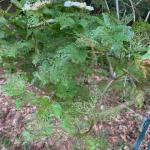
 Viburnum Leaf Beetle: Pyrrhalta viburni is a beetle in the family Chrysomelidae that is native to Europe, but was found in Massachusetts in 2004. Viburnum leaf beetle overwinters as eggs laid in capped pits on the newest growth of susceptible viburnum branches. Egg hatch occurs in late-April to early-May as temperatures warm and foliage becomes available. Monitor for larvae in mid-May (80-120 GDD’s). Recently, reports of viburnum leaf beetle larval feeding to UMass Extension have increased, likely because feeding damage is more apparent at this time. Feeding larvae were seen and reported on 5/31/20 in Southampton, MA and Pelham, MA. This beetle feeds exclusively on many different species of viburnum, which includes, but is not limited to, susceptible plants such as V. dentatum, V. nudum, V. opulus, V. propinquum, and V. rafinesquianum. Some viburnum have been observed to have varying levels of resistance to this insect, including but not limited to V. bodnantense, V. carlesii, V. davidii, V. plicatum, V. rhytidophyllum, V. setigerum, and V. sieboldii. More information about viburnum leaf beetle may be found at http://www.hort.cornell.edu/vlb/ .
Viburnum Leaf Beetle: Pyrrhalta viburni is a beetle in the family Chrysomelidae that is native to Europe, but was found in Massachusetts in 2004. Viburnum leaf beetle overwinters as eggs laid in capped pits on the newest growth of susceptible viburnum branches. Egg hatch occurs in late-April to early-May as temperatures warm and foliage becomes available. Monitor for larvae in mid-May (80-120 GDD’s). Recently, reports of viburnum leaf beetle larval feeding to UMass Extension have increased, likely because feeding damage is more apparent at this time. Feeding larvae were seen and reported on 5/31/20 in Southampton, MA and Pelham, MA. This beetle feeds exclusively on many different species of viburnum, which includes, but is not limited to, susceptible plants such as V. dentatum, V. nudum, V. opulus, V. propinquum, and V. rafinesquianum. Some viburnum have been observed to have varying levels of resistance to this insect, including but not limited to V. bodnantense, V. carlesii, V. davidii, V. plicatum, V. rhytidophyllum, V. setigerum, and V. sieboldii. More information about viburnum leaf beetle may be found at http://www.hort.cornell.edu/vlb/ .
Concerned that you may have found an invasive insect or suspicious damage caused by one? Need to report a pest sighting? If so, please visit the Massachusetts Introduced Pests Outreach Project: http://massnrc.org/pests/pestreports.htm .
A note about Tick Awareness: deer ticks (Ixodes scapularis), the American dog tick (Dermacentor variabilis), and the lone star tick (Amblyomma americanum) are all found throughout Massachusetts. Each can carry their own complement of diseases. Anyone working in tick habitats (wood-line areas, forested areas, and landscaped areas with ground cover) should check themselves regularly for ticks while practicing preventative measures. Have a tick and need it tested? Visit the web page of the UMass Laboratory of Medical Zoology https://www.tickreport.com/ and click on the blue Order a TickReport button for more information.
Reported by Tawny Simisky, Extension Entomologist, UMass Extension Landscape, Nursery, & Urban Forestry Program
Weeds
Summer annual grass and broadleaf weeds are becoming increasingly more apparent in mulched landscape beds. Most summer annuals have germinated and are getting larger with the warmer weather. Some weeds have become sizable and spraying them will result in unsightly dead vegetation, so hand weeding may be necessary. However, spot spraying with a non-selective herbicide is usually a better strategy than hand-weeding because it does not break the mulch barrier unless the plant is clipped below the stem base. Determination on a site-by-site basis will be needed to select the best strategy. Inspect the mulch layer to ensure that it is thick enough to control future weed problems.
Many landscape trees commonly produce vegetative suckers at their trunk base. Suckers are commonly seen on crabapple, flowering cherry, flowering pear, plum, linden, maple and sometimes oak. Honeylocust commonly produces vegetative sprouts along the entire length of their truck. If these suckers or sprouts are not controlled, the landscape will be a contender for the “shabby landscape award”. Pruning is effective but very time consuming. Another option would be use the product ScytheTM that contains pelargonic acid to remove these vegetative suckers and sprouts when they are very small. Very small means less than one inch in length or smaller. Pelargonic acid is a contact herbicide. If ScytheTM is applied to small suckers and sprouts, the product will desiccate them and physical removal will not be required. Larger growth will first need to be physically removed and then ScytheTM can be used as a maintenance program. Products that contain glyphosate should not be used as glyphosate is a translocated (systemic) herbicide and injury is possible.
Do not delay, treat garlic mustard, Alliaria petiolata, now. Plants have matured to a point were seedpods have formed and the seeds are not yet mature as they are still green. Garlic mustard is a biennial and herbicide applications at this time of year will control second-year plants before they go to seed as well as the first-year seedlings.
New growth expansion of poison ivy continues. Poison ivy is flowering so it should be treated now. Application can be done from now to mid-September.
Do not attempt to control Japanese knotweed, Polygonum cuspidatum, at this time as herbicide applications are not effective. In preparation for a late season herbicide application, cut or mow stands of knotweed to the ground in late May and early June. This practice is done to facilitate herbicide application by removing the dried stems from the previous year’s growth and will control plant height so knotweed will be shorter at time of treatment in late summer. There is also some indication that the plant’s carbohydrate reserves may be reduced with this early season mowing.
Report by Randy Prostak, Weed Specialist, UMass Extension Landscape, Nursery and Urban Forestry Program
Landscape Turf
Insects
White grubs: The window of opportunity for preventive diamide applications (chlorantraniliprole) has ended. The next window of opportunity for annual grub preventive management will be in July when adults are flying and laying eggs. During that time, the recommended options are neonicotinoids, which target hatching young larvae.
By now, most white grub species are finishing their development and getting ready to transform to adults. So, no curative applications are recommended at this time. European chafers are expected to be flying very soon (mid-June in Massachusetts).
May/June (Phyllophaga spp.) beetles were flying at the end of the last week (Fig.1,2). Adult beetles are attracted to lights and often dead beetles can be spotted near the lights the next day. May/June beetles take three years to complete development from eggs to adult beetles. These are an occasional and usually localized problem for turf. Adults feed on shade and forest tree foliage, and often prefer oaks. Similar to annual white grub species, May/June beetle larvae feed on grass roots, and can potentially cause damage. In addition, larvae can feed on the roots of shade, forest and even Christmas trees, which can be damaging to the young trees.
Billbugs: During the past 2-3 weeks we have observed increased billbug adult activity. Adult billbugs usually overwinter in sheltered areas and come back to turf at this time of year to feed, mate and lay eggs. Small (1-2 instar) billbug larvae feed inside the plant. Later larvae come out of the plant and feed on the crowns, causing severe turf damage. Damage is most apparent in July, especially if the weather conditions are dry (Fig 3). If a high-density population was noticed last year, now is a good time to consider preventive application. Systemic insecticides (neonicotinoids and diamides) are the best option for the larvae feeding inside of the stem.
Submitted by: Dr. Olga Kostromytska and Dr. Pat Vittum
Cultural Practices
Humidity and Water Management are Critical for Lawn Disease Prevention: Turf disease development is strongly influenced by environmental conditions within the turf canopy and the soil around the root zone. Temperature plays a role of course; for instance, red thread is typically seen in cooler weather, while brown patch appears in the heat of the summer. Free moisture and humidity also play a key role in promoting disease. Most fungi that cause plant diseases require free moisture to be available on plant surfaces for a certain amount of time for spore germination and infection to occur, and high humidity further promotes disease development.
While we can’t do anything about the weather, there are things that turf professionals can do to decrease humidity and free moisture in the turf microclimate and make conditions less hospitable to pathogenic fungi. This involves active effort to keep leaf wetness periods as short as possible, and facilitating rapid drying of foliage after rain or irrigation. This can be accomplished by increasing air circulation and sun exposure on the turf; factors that are best considered prior to turf establishment but may be improved for existing sites by strategically pruning or removing trees and shrubs. Examples of more targeted practices include dragging a hose over turf in the early morning to speed drying by knocking dew off the leaf blades.
Watering is best done in the early morning, as increasing temperatures and sunlight will promote rapid drying of foliage as the day progresses. To maintain growth during summer, a general guideline for lawns in Southern New England is one inch of moisture input per week from either precipitation, supplemental irrigation, or a combination thereof. Watering deeply and infrequently is the best way to manage soil moisture in lawns. This practice also promotes the development of deep roots, an important characteristic that makes turf less susceptible to environmental stress and diseases. Excessively wet soil is not only conducive to numerous diseases, but the exclusion of oxygen in waterlogged soil also impairs proper root function, weakening turf and making it more susceptible to pathogens.
Submitted by: Dr. Angela Madeiras
Additional Resources
To receive immediate notification when the next Landscape Message update is posted, join our email list by emailing your request to eweeks@umext.umass.edu with Subscribe Greeninfo in the subject line, and follow us on Facebook and Twitter.
For a complete listing of upcoming events, see our upcoming educational events https://ag.umass.edu/landscape/upcoming-events
For commercial growers of greenhouse crops and flowers - Check out UMass Extension's Greenhouse Update website
For professional turf managers - Check out Turf Management Updates
For home gardeners and garden retailers - Check out our home lawn and garden resources. UMass Extension also has a Twitter feed that provides timely, daily gardening tips, sunrise and sunset times to home gardeners at twitter.com/UMassGardenClip
New Online Offering from UMass Extension’s Pesticide Education Program:
Are you looking for continuing education contact hours and the 2020 Pesticide Recertification Workshops from UMass Extension’s Pesticide Education Program? Topics include MA Pesticide Laws and Regulations, Pesticide Respirator Fit Test: Train the Trainer, Pesticides and Impacts on Wildlife, Fungicides: Modes of Action and Resistance Management, and more! Cost is $40 per person, per 2.5 hour workshop. To register and to find out more information, visit:
https://www.umass.edu/pested/recertification/current_workshops.htm
Current Massachusetts and University policies have the effect of temporarily suspending most of the on-campus services that we provide, including but not limited to:
- Soil and Plant Nutrient Testing Lab
- Plant Disease Diagnostics Lab
- Weed, Insect, Turfgrass, and Invasive Plant Identification
Until further notice, please do not send or deliver samples to the campus, as we cannot process them.
Diagnostic Services
A UMass Laboratory Diagnoses Landscape and Turf Problems - The UMass Extension Plant Diagnostic Lab is available to serve commercial landscape contractors, turf managers, arborists, nurseries and other green industry professionals. It provides woody plant and turf disease analysis, woody plant and turf insect identification, turfgrass identification, weed identification, and offers a report of pest management strategies that are research based, economically sound and environmentally appropriate for the situation. Accurate diagnosis for a turf or landscape problem can often eliminate or reduce the need for pesticide use. For sampling procedures, detailed submission instructions and a list of fees, see Plant Diagnostics Laboratory . No samples are being accepted at this time.
Soil and Plant Nutrient Testing - The University of Massachusetts Soil and Plant Nutrient Testing Laboratory is located on the campus of The University of Massachusetts at Amherst. Testing services are available to all. The function of the Soil and Plant Nutrient Testing Laboratory is to provide test results and recommendations that lead to the wise and economical use of soils and soil amendments. For complete information, visit the UMass Soil and Plant Nutrient Testing Laboratory web site. Alternatively, call the lab at (413) 545-2311. No samples are being accepted at this time.
Due to unprecedented circumstances of the global pandemic, the University of Massachusetts has mandated work furloughs for all university staff. Unfortunately this order comes at the annual peak of tick activity, and hence TickReport testing will not be available during the furlough. Effective at 11:59PM on 3-June-2020, until 12:01AM on 19-June-2020, TickReport will not be accepting new orders. For a full statement from TickReport, please visit: https://www.tickreport.com . Please contact TickReport with further questions and updates on the status of their service.
Ticks are active any time that temperatures are above freezing! Remember to take appropriate precautions when working and playing outdoors, and conduct daily tick checks. UMass tests ticks for the presence of Lyme disease and other disease pathogens. Learn more
